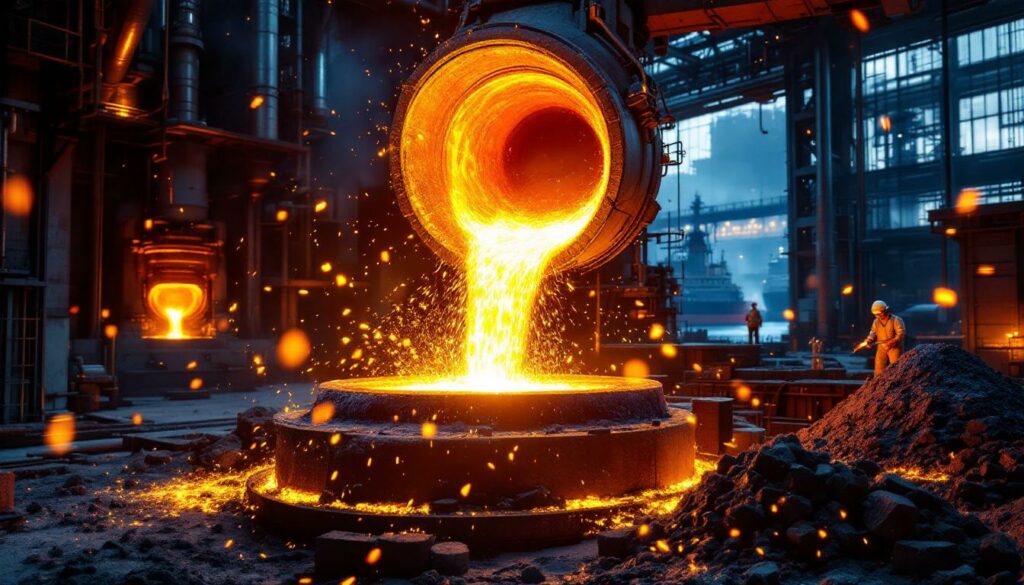What's Driving the Current Ferrous Metals Market?
The ferrous metals market has experienced a notable pattern recently: initial decline followed by recovery, with raw material support outpacing finished products. This dynamic reflects several interrelated factors that market participants and investors should monitor closely to navigate the current environment.
Geopolitical Tensions Creating Market Uncertainty
Geopolitical developments have significantly influenced market sentiment and price movements across the ferrous metals spectrum. In late June 2025, the Iranian Parliament passed a resolution regarding the potential blockade of the Strait of Hormuz, sending shock waves through commodity markets. The resolution, pending approval from the Supreme National Security Council, raised serious concerns about potential supply disruptions in a critical global shipping lane.
"Geopolitical tensions, particularly involving key shipping routes like the Strait of Hormuz, can create ripple effects throughout the entire ferrous metals supply chain, from iron ore shipments to finished steel delivery schedules." – SMM Analysis, June 2025
While the June 24th ceasefire announcement between Israel and Iran provided temporary relief to markets, ongoing friction between the nations continues to create an atmosphere of uncertainty. This uncertainty has kept market participants cautious about medium-term supply reliability.
Raw Material Supply Constraints Tightening Markets
Several concurrent factors are creating noticeable tightness in raw material markets:
- Enhanced safety inspections at coal mines across major producing regions are limiting production outputs and shipments
- Mongolia's five-day Naadam Festival closure disrupted cross-border supply chains at a critical time
- A significant mine accident in Changzhi, Shanxi Province further constrained coking coal production
- Seasonal weather patterns (high temperatures and rainfall) reducing processing efficiency and logistics capabilities
These constraints have collectively strengthened expectations of tighter coking coal supply, providing substantial support for raw material prices. Simultaneously, the stabilization and subsequent increase in pig iron production have bolstered demand fundamentals.
How Are Supply-Demand Dynamics Shaping the Market?
The current market reflects a complex interplay between supply constraints and evolving demand patterns across the ferrous metals value chain. Understanding these dynamics is crucial for anticipating price movements in coming weeks.
Pig Iron Production Rebounds
According to comprehensive SMM survey tracking, pig iron production has not only halted its previous decline but is now showing clear signs of recovery. This trend reversal provides fundamental support for raw material prices throughout the supply chain.
Key production indicators:
- Production decline arrested in early June
- Modest but consistent production increases since mid-June
- Short-term expectations point to continued rebound through July
- Regional variations with stronger recovery in northern production hubs
This production rebound directly strengthens demand for iron ore, coking coal, and other steelmaking inputs, creating a positive feedback loop for raw material support despite seasonal headwinds.
Seasonal Demand Patterns Emerge
The market is displaying typical seasonal characteristics as summer temperatures rise:
- The traditional steel consumption off-season has definitively arrived
- End-users are adopting cautious purchasing strategies, buying raw materials primarily on an as-needed basis
- Spot-futures price spreads have notably narrowed as market participants adjust expectations
- Some forward-looking traders are engaging in strategic purchasing for future delivery
- Despite the seasonal slowdown, overall demand remains relatively resilient compared to historical off-season patterns
This balance of cautious purchasing alongside strategic inventory building by some market participants suggests the potential for rapid price movements when seasonal demand returns.
What's the Outlook for Key Ferrous Metal Categories?
Iron Ore Market Analysis
Iron ore fundamentals maintain relative strength despite seasonal pressures, creating a balanced market environment. Overseas shipments from major producing regions are expected to continue their gradual increase through summer.
Supply factors:
- Australian and Brazilian exports maintaining stable or slightly increasing volumes
- Supply-side pressure remains moderate compared to historical patterns
- Logistics disruptions minimal barring new geopolitical developments
Demand drivers:
- Blast furnace pig iron production rebound providing sustained price support
- Off-season demand and lack of macroeconomic stimulus limiting upward momentum
- Regional stockpiling variations showing divergent strategies among steel producers
The near-term outlook suggests a fluctuating range-bound trend for iron ore price trends, with limited potential for dramatic movements in either direction absent new disruptive factors.
Coke Market Conditions
The coke market demonstrates tangible signs of stabilization after a period of volatility:
Production economics:
- Several coking enterprises experiencing margin compression or outright losses
- Strategic production reductions implemented by loss-making producers
- Resulting slight tightening of overall coke supply
Market sentiment:
- Improved sentiment stabilizing sales activities
- Steel mills' profitability showing modest improvement
- Gradual recovery in coke demand as production requirements stabilize
- Increased enthusiasm for inventory replenishment among forward-looking buyers
Supply constraints:
- Safety inspections remaining particularly strict in coal mining regions following incidents
- Coking coal supply decreases following the significant mine accident in Shanxi Province
- Online auctions showing positive momentum with smooth sales execution and price rebounds
The coke market appears positioned to temporarily stabilize at current levels, with potential for modest upside if safety-related supply constraints persist.
How Are Finished Steel Products Performing?
Rebar Market Dynamics
The rebar market exhibits early warning signs of supply-demand imbalance that warrant close attention from market participants:
Current pricing:
- Nationwide average price: 3,061 yuan/mt (down 28 yuan/mt month-on-month)
- Regional variations with southern markets facing greater pressure
Supply factors:
- Some manufacturers operating at break-even or experiencing slight losses
- Production cuts or shifts to alternative steel varieties occurring among marginal producers
- Most blast furnace mills maintaining production due to sustainable profit margins
- Electric arc furnace (EAF) mills facing persistent losses (except in Sichuan, where electricity subsidies provide support)
- Potential further decline in electric furnace mill operating rates as losses continue
Demand challenges:
- Severe weather conditions in southwest and south China significantly impacting shipments and construction activities
- Demand in east and north China maintaining relative stability despite seasonal pressures
- High-temperature weather affecting terminal outdoor working hours and productivity
- Difficulty in demand improvement during traditional summer off-season
Inventory trends:
- In-plant inventory beginning to accumulate as production exceeds immediate demand
- Steel agents reducing inventory pressure through direct mill shipments
- Diverging trends between in-plant and social inventory likely to continue in the near term
The short-term outlook suggests fundamental contradictions accumulating in the rebar market. While raw material strength provides cost support, construction steel faces challenges developing an independent trend. Market expectations center on range-bound spot price fluctuation, with the RB2510 contract likely to trade within the 2,900-3,050 yuan/mt range.
Hot-Rolled Coil (HRC) Market Assessment
The hot-rolled coil market demonstrates notable resilience despite facing similar seasonal challenges to other steel products:
Price patterns:
- Recent trajectory shows initial decline followed by meaningful rebound
- Significant price increase observed on the final trading day of the reporting period
- Average market trading atmosphere with decreased weekly transaction volume
Supply dynamics:
- Production increasing as the impact of maintenance schedules decreases
- Mill operating rates trending higher as profitability supports production
Demand factors:
- Obvious off-season impact dampening immediate consumption
- High-temperature and rainfall warnings further reducing apparent demand
- Regional variations in end-user purchasing activity
Inventory situation:
- Social inventory: 3.0017 million mt (up 22,200 mt or 0.75% month-on-month)
- Regional variations revealing important market differences:
- Continued inventory decline in east China
- Accumulation in central, south, north, and northeast regions
Cost considerations:
- Fourth round of coke price reductions successfully implemented
- Slight rise in iron ore prices creating offsetting effects
- Overall slight weakening of cost support compared to previous period
The short-term outlook for HRC suggests fundamental contradictions in the accumulation stage, but with relatively limited negative impact. The stabilization of coke prices combined with increases in iron ore prices provides stable cost support. Most-traded HRC contracts are expected to demonstrate resilience, likely holding within the 3,070-3,170 yuan range.
What's Happening in the Steel Scrap Market?
Supply and Demand Patterns
The steel scrap market continues to demonstrate persistent weakness in both supply and demand fundamentals, creating a uniquely balanced but subdued market environment.
Supply constraints:
- High temperatures and rainy weather significantly reducing processing base operating rates
- Decreased recycling efficiency due to weather conditions
- Reduced market circulation of scrap resources
- Cautious market outlook limiting stockpiling activities among collectors
- Historically low social inventory levels limiting availability
Demand challenges:
- Blast furnace mills strategically reducing steel scrap usage due to lower fuel prices and reduced pig iron costs
- EAF steel mills facing escalating costs and increasing financial losses
- Increasing production shutdowns and maintenance periods among electric arc furnace operators
- Shift in input mix favoring alternative charge materials over scrap in integrated mills
Market outlook:
- Persistent pattern of weak supply meeting equally weak demand
- Structurally tight steel scrap resources despite reduced consumption
- Notable trader reluctance to sell existing inventory at current price levels
- Price direction more likely to trend upward than downward in the short term despite demand weakness
The scrap market's unique dynamics highlight how weather factors, production economics, and inventory strategies can create balanced markets even amid challenging conditions for both buyers and sellers.
What Factors Will Influence the Market Going Forward?
Key Indicators to Monitor
Several critical factors will demand close attention from market participants seeking to anticipate upcoming price movements and market trends:
Macroeconomic indicators:
- PMI data release in early July will provide crucial insight into manufacturing sentiment
- Industrial production figures and capacity utilization rates
- Construction investment metrics, particularly in infrastructure projects
- Potential policy adjustments from central authorities
Operational factors:
- Changes in steel mill production conditions and maintenance schedules
- Raw material inventory levels at major ports and steel facilities
- Mill profitability metrics across product categories
- Electric arc furnace versus blast furnace operating rates
External variables:
- Weather patterns affecting construction activity and logistics
- Further developments in geopolitical tensions, particularly in the Middle East
- Energy prices and their impact on production costs
- Currency movements affecting import/export economics
Seasonal transitions:
- Timeline for traditional demand recovery post-summer slowdown
- Regional variations in seasonal demand patterns
- Inventory positioning ahead of potential demand improvement
Supply-Demand Balance Outlook
The current market demonstrates a gradual accumulation of supply-demand imbalance rather than acute disequilibrium. This suggests measured price movements rather than dramatic shifts in the near term:
Raw material support:
- Remains relatively solid in the short term
- Safety inspections and weather impacts maintaining supply tightness
- Production rebounding creates sustainable demand base
Steel price stability:
- Finished steel prices expected to demonstrate resilience despite seasonal pressures
- Cost support provides floor for potential declines
- Limited downside risk absent major macroeconomic deterioration
Demand patterns:
- Seasonal characteristics emerging but sharp decline appears unlikely
- Overall demand maintaining resilience compared to historical off-seasons
- Regional bright spots offsetting areas of weakness
Market balance:
- Supply-demand imbalance accumulating gradually rather than rapidly
- Raw material strength creating foundation for finished steel stability
- Potential for quicker recovery when seasonal factors abate
FAQ: Understanding the Ferrous Metals Market
How are geopolitical tensions affecting the ferrous metals market?
Geopolitical tensions, particularly the Israel-Iran conflict, have introduced significant uncertainty into market sentiment. The Iranian Parliament's resolution regarding potential restrictions in the Strait of Hormuz raised serious concerns about potential supply disruptions in a critical global shipping lane. While the June 24th ceasefire announcement provided temporary relief to markets, ongoing friction continues to influence market sentiment and contribute to price volatility.
The impact extends beyond immediate price movements to affect inventory strategies, with some market participants maintaining higher safety stocks to mitigate potential supply disruptions. This risk-hedging behavior further tightens available market supply.
Why are raw materials outperforming finished products in the current market?
Raw materials are demonstrating stronger performance than finished products due to a combination of supply constraints and demand resilience. Enhanced safety inspections at coal mines following incidents, supply disruptions from Mongolia's Naadam Festival, and weather-related production challenges have all contributed to tighter raw material markets.
Simultaneously, the stabilization and increase in pig iron production has strengthened demand fundamentals for these inputs. While finished steel products face seasonal demand challenges and regional weather disruptions affecting consumption, the raw material supply chains face more acute constraints, creating stronger price support.
What is the expected trend for iron ore prices in the short term?
Iron ore prices are expected to maintain a fluctuating, range-bound trend in the short term. While overseas shipments from Australia and Brazil continue at stable or slightly increasing volumes, the blast furnace pig iron production rebound provides meaningful demand support.
However, off-season consumption patterns and the absence of significant macroeconomic stimulus limit upward momentum. The overall iron ore decline analysis suggests supply-side pressure remains moderate compared to historical patterns, creating a balanced market environment that supports price stability within established ranges.
How is the traditional off-season affecting steel demand?
The traditional summer off-season is influencing purchasing behavior across the steel value chain. End-users have adopted more cautious purchasing strategies, buying raw materials primarily on an as-needed basis rather than building significant inventory positions. This has narrowed spot-futures price spreads as market participants adjust near-term expectations.
High-temperature weather conditions are significantly affecting terminal outdoor working hours, particularly in construction sectors, making demand improvement challenging during this period. However, iron ore demand insights indicate demand appears relatively resilient compared to historical off-seasons, suggesting potential for faster recovery when seasonal factors abate.
Further Exploration: Understanding Raw Material Support in Ferrous Metals Markets
Readers seeking deeper insights into ferrous metals market dynamics can explore what are ferrous alloys in more detail to understand the fundamental properties that drive market demand. Additionally, understanding how tariffs impact on iron ore markets helps contextualize current price movements within broader trade policy frameworks.
The interplay between raw material costs, production economics, and finished steel pricing creates opportunities for market participants who understand these relationships. As the market navigates the current period of seasonal adjustment, maintaining perspective on these fundamental connections will remain essential for anticipating future price movements and market trends. Those interested in supply fundamentals should also be aware of the largest iron ore mines that anchor global production capacity.
Are You Missing Out on the Next Major Mineral Discovery?
Discover significant ASX mineral discoveries the moment they happen with Discovery Alert's proprietary Discovery IQ model, turning complex data into actionable insights for both short-term traders and long-term investors. Explore how historic discoveries have generated substantial returns by visiting the Discovery Alert discoveries page and position yourself ahead of the market with your 30-day free trial.




